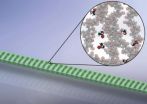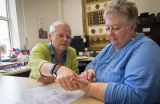(Press-News.org) WASHINGTON D.C., June 17, 2014 – Using microscopic polymer light resonators that expand in the presence of specific gases, researchers at MIT's Quantum Photonics Laboratory have developed new optical sensors with predicted detection levels in the parts-per-billion range. Optical sensors are ideal for detecting trace gas concentrations due to their high signal-to-noise ratio, compact, lightweight nature, and immunity to electromagnetic interference.
Although other optical gas sensors had been developed before, the MIT team conceived an extremely sensitive, compact way to detect vanishingly small amounts of target molecules. They describe their new approach in the journal Applied Physics Letters, from AIP Publishing.
The researchers fabricated wavelength-scale photonic crystal cavities from PMMA, an inexpensive and flexible polymer that swells when it comes into contact with a target gas. The polymer is infused with fluorescent dye, which emits selectively at the resonant wavelength of the cavity through a process called the Purcell effect. At this resonance, a specific color of light reflects back and forth a few thousand times before eventually leaking out. A spectral filter detects this small color shift, which can occur at even sub-nanometer level swelling of the cavity, and in turn reveals the gas concentration.
"These polymers are often used as coatings on other materials, so they're abundant and safe to handle. Because of their deformation in response to biochemical substances, cavity sensors made entirely of this polymer lead to a sensor with faster response and much higher sensitivity," said Hannah Clevenson. Clevenson is a PhD student in the electrical engineering and computer science department at MIT, who led the experimental effort in the lab of principal investigator Dirk Englund.
PMMA can be treated to interact specifically with a wide range of different target chemicals, making the MIT team's sensor design highly versatile. There's a wide range of potential applications for the sensor, said Clevenson, "from industrial sensing in large chemical plants for safety applications, to environmental sensing out in the field, to homeland security applications for detecting toxic gases, to medical settings, where the polymer could be treated for specific antibodies."
The thin PMMA polymer films, which are 400 nanometers thick, are patterned with structures that are 8-10 micrometers long by 600 nanometers wide and suspended in the air. In one experiment, the films were embedded on tissue paper, which allowed 80 percent of the sensors to be suspended over the air gaps in the paper. Surrounding the PMMA film with air is important, Clevenson said, both because it allows the device to swell when exposed to the target gas, and because the optical properties of air allow the device to be designed to trap light travelling in the polymer film.
The team found that these sensors are easily reusable since the polymer shrinks back to its original length once the targeted gas has been removed.
The current experimental sensitivity of the devices is 10 parts per million, but the team predicts that with further refinement, they could detect gases with part-per-billion concentration levels.
INFORMATION:
The article, "High sensitivity gas sensor based on high-Q suspended polymer photonic crystal nanocavity," is authored by H. Clevenson, P. Desjardins, X. Gan, D. Englund. It will be published in Applied Physics Letters on June 17, 2014. (DOI: 10.1063/1.4879735). After that date, it may be accessed at: http://scitation.aip.org/content/aip/journal/apl/104/24/10.1063/1.4879735
ABOUT THE JOURNAL
Applied Physics Letters features concise, rapid reports on significant new findings in applied physics. The journal covers new experimental and theoretical research on applications of physics phenomena related to all branches of science, engineering, and modern technology. See: http://apl.aip.org
Swell new sensors
MIT researchers make novel, high sensitivity optical sensors that swell when exposed to a target gas -- potential industrial, security, environmental, and medical applications
2014-06-17
ELSE PRESS RELEASES FROM THIS DATE:
Ultra-thin wires for quantum computing
2014-06-17
WASHINGTON D.C., June 17, 2014 - Take a fine strand of silica fiber, attach it at each end to a slow-turning motor, gently torture it over an unflickering flame until it just about reaches its melting point and then pull it apart. The middle will thin out like a piece of taffy until it is less than half a micron across -- about 200 times thinner than a human hair.
That, according to researchers at the Joint Quantum Institute at the University of Maryland, is how you fabricate ultrahigh transmission optical nanofibers, a potential component for future quantum information ...
Study reveals conditions linked to deadly bird flu and maps areas at risks
2014-06-17
BEIJING, CHINA (17 June 2014)—A dangerous strain of avian influenza, H7N9, that's causing severe illness and deaths in China may be inhabiting a small fraction of its potential range and appears at risk of spreading to other suitable areas of India, Bangladesh, Vietnam, Indonesia and the Philippines, according to a new study published today in the journal Nature Communications.
Researchers from the Université Libre de Bruxelles (ULB), the International Livestock Research Institute (ILRI), Oxford University, and the Chinese Center of Disease Control and Prevention analyzed ...
Potential cholesterol lowering drug has breast cancer fighting capabilities
2014-06-17
COLUMBIA, Mo. – Researchers at the University of Missouri have proven that a compound initially developed as a cholesterol-fighting molecule not only halts the progression of breast cancer, but also can kill the cancerous cells.
"Cholesterol is a molecule found in all animal cells and serves as a structural component of cell membranes," said Salman Hyder, the Zalk Endowed Professor in Tumor Angiogenesis and professor of biomedical sciences in the College of Veterinary Medicine and the Dalton Cardiovascular Research Center at MU. "Because tumor cells grow rapidly they ...
Bats make social alliances that affect roosting behavior
2014-06-17
Depending on habitat availability, the endangered Indiana bat may be able to use its social connections to survive a certain amount of roost destruction, according to research by scientists at Virginia Tech and The Ohio State University.
Alexander Silvis of Lynchburg, Ohio, and Andrew Kniowski of Boones Mill, Virginia, both doctoral students in Virginia Tech's College of Natural Resources and Environment, made findings from Ohio State field studies highly visual by applying graphic and spatial approaches to the data.
"Social dynamics are important to bat roosting behavior," ...
Researchers map genomic differences in yellow fever, malaria mosquitoes
2014-06-17
Virginia Tech entomologists have developed a chromosome map for about half of the genome of the mosquito Aedes agypti, the major carrier of dengue fever and yellow fever.
With the map, researchers can compare the chromosome organization and evolution between this mosquito and the major carrier of malaria, the Anopheles gambiae mosquito, to find ways to prevent diseases.
"Despite looking somewhat similar, these mosquitoes diverged from each other about 150 million years ago. So, they are genetically further apart than humans and elephants," said Maria Sharakhova, a ...
Study reveals livestock gut microbes contributing to greenhouse gas emissions
2014-06-17
"Increased to levels unprecedented" is how the Intergovernmental Panel on Climate Change (IPCC) described the rise of carbon dioxide, methane and nitrous oxide emissions in their report on the physical science basis of climate change in 2013. According to the US Environmental Protection Agency (EPA), the atmospheric concentration of methane, a greenhouse gas some 28 times more potent than carbon dioxide has been steadily growing since the 18th century and has now increased by 50 percent compared to pre-industrial levels, exceeding 1,800 parts per billion.
The EPA attributes ...
'Vital signs' of teaching captured by quick, reliable in-class evaluation
2014-06-17
A 20-minute classroom assessment that is less subjective than traditional in-class evaluations by principals can reliably measure classroom instruction and predict student standardized test scores, a team of researchers researchers reported.
The assessment also provides immediate and meaningful feedback making it an important new tool for understanding and improving instructional quality, according to psychologists from the University of Rochester and the University of North Carolina at Chapel Hill.
"Education researchers broadly agree that teachers matter," explained ...
EHRA White Book 2014 highlights growing use of complex therapies for heart rhythm abnormalities
2014-06-17
Nice, France, 17 June 2014. The EHRA (European Heart Rhythm Association) White Book 2014 will be officially launched at the CARDIOSTIM EHRA EUROPACE 2014 congress which starts today in Nice, France.
The White Book reports on the current status of arrhythmia treatment in 49 of the 56 European Society of Cardiology (ESC) member countries for the year 2013. The new White Book is published in electronic format only and will be distributed on a USB stick as well as being available on the EHRA website. As a new feature, the USB stick contains complete data also from the six ...
Distracted minds still see blurred lines
2014-06-17
VIDEO:
Participants were asked to look at an image with moving sections blurred, while performing a cognitive 'n-back' task.
Click here for more information.
Montreal, June 17, 2014 — From animated ads on Main Street to downtown intersections packed with pedestrians, the eyes of urban drivers have much to see. But while city streets have become increasingly crowded with distractions, our ability to process visual information has remained unchanged for millions of years. ...
Pain pilot explores hand shiatsu treatment as sleep aid
2014-06-17
(Edmonton) There was a time, back in Nancy Cheyne's youth, when she combined the poise and grace of a ballerina with the daring and grit of a barrel racer. When she wasn't pursuing either of those pastimes, she bred sheepdogs, often spending hours on her feet grooming her furry friends at dog shows.
All that seems like a lifetime ago. After 15 years of living with chronic lower-back pain, Cheyne, 64, can't walk from the disabled parking stall to the elevator at work without stopping for a rest. She eats mostly junk food because it hurts too much to stand over the stove ...
LAST 30 PRESS RELEASES:
Drone sampling of whale breath reveals first evidence of potentially deadly virus in Arctic
Roman soldiers defending Hadrian’s Wall infected by parasites, study finds
Pinochet’s prisoners were tormented with music but still found solace in it, a new book reveals
Fertility remains high in rural Tanzania despite access to family planning
AI-assisted device can improve autism care access
Kinetic careers
Uncovering how parasitic plants avoid attacking themselves to improve crop resistance
Nanoparticle vaccine strategy could protect against Ebola and other deadly filoviruses
Study finds brain care score can predict risk of stroke across racial groups
Key lung immune cells can intensify allergic reactions
Do hormones explain why women experience more gut pain?
New materials conduct ions in solids as easily as in liquids
Breakthrough of the Year: Renewable energy begins to eclipse fossil fuel-based sources
LLM use is reshaping scientific enterprise by increasing output, reducing quality and more
Introducing LightGen, a chip for ultra-fast, ultra-efficient generative AI
Astronomers see fireworks from violent collisions around nearby star
ACC/AHA issue new guideline on managing congenital heart disease in adults
Cosmic crash caught on camera
Is talented youth nurtured the wrong way? New study shows: top performers develop differently than assumed
Ants: An untapped resource in the development of antibiotics?
Archaeologists use AI to create prehistoric video game
Mitochondria migrate toward the cell membrane in response to high glucose levels
Tiny viral switch offers hope against drug-resistant bacteria
Most parents aware of early peanut introduction guidelines, but confused about details
HPV vaccine can protect against severe lesions of the vulva and vagina
Virtual care provision and emergency department use among children and youth
Quadrivalent HPV vaccine and high-grade vulvovaginal lesions
Insights into dry eyes gained from stem cell-derived tear glands
Researchers identify 166 human pluripotent stem cell lines available for use in clinical applications
Europa Clipper instrument uniquely observed interstellar comet 3I/ATLAS
[Press-News.org] Swell new sensorsMIT researchers make novel, high sensitivity optical sensors that swell when exposed to a target gas -- potential industrial, security, environmental, and medical applications





